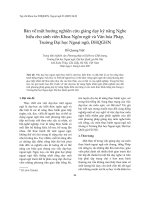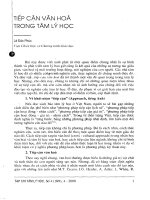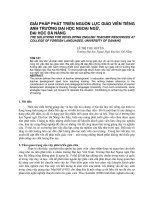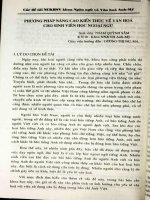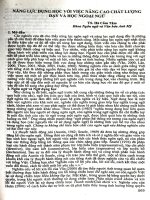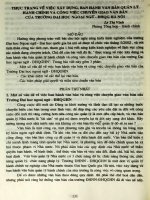NÂNG CAO NĂNG LỰC GIAO TIẾP GIAO VĂN HÓA TRONG DẠY VÀ HỌC NGOẠI NGỮ
Bạn đang xem bản rút gọn của tài liệu. Xem và tải ngay bản đầy đủ của tài liệu tại đây (1.02 MB, 11 trang )
<span class='text_page_counter'>(1)</span><div class='page_container' data-page=1>
<b>Tập 183, số 07, 2018</b>
Tập 183
, Số 07
</div>
<span class='text_page_counter'>(2)</span><div class='page_container' data-page=2>
<i> </i>
Tạp chí Khoa học và Công nghệ
CHUYÊN SAN KHOA HỌC XÃ HỘI – NHÂN VĂN – KINH TẾ
Môc lôc
Trang
Hồng Thị Phương Nga - Mơ hình du lịch văn học “Làng Vũ Đại ngày ấy” 3
<i>Phạm Thị Thu Hồi, Trần Thị Thanh - Tiếng lóng trong truyện về đề tài giáo dục của Văn Thành Lê </i>9
Ngô Thị Thanh Nga, Phạm Thị Hồng Vân - Vài nét về các phương thức thể hiện tình vợ chồng trong văn
học trung đại Việt Nam 15
Nguyễn Thị Thắm,Nguyễn Minh Sơn - Ý thức đối thoại của Nguyễn Ngọc Tư với văn học truyền thống thông
<i>qua những nhân vật nữ trong tập truyện Không ai qua sông </i> 21
Đặng Thị Thùy, Nguyễn Diệu Thương - Lơ gích của các hiện tượng “phi lơ gích” trong ca dao, tục ngữ
người Việt 27
Đinh Thị Giang - Những nhân tố ảnh hưởng đến lối sống của người Việt ở đồng bằng Bắc Bộ hiện nay 33
Nguyễn Diệu Thương, Nguyễn Thị Lan Hương - Phương thức tạo hàm ý trong tiểu phẩm trào phúng 39
<i>Nguyễn Thu Quỳnh, Vì Thị Hiền - Từ ngữ chỉ đồ gia dụng trong tiếng Thái ở tỉnh Điện Biên </i> 45
Nguyễn Thị Thu Oanh, Hoàng Thị Mỹ Hạnh - Vị thế, vai trò cầm quyền của Đảng Cộng Sản Việt Nam giai
đoạn 1945 - 1975 và một số bài học kinh nghiệm 51
Đỗ Hằng Nga, Phạm Quốc Tuấn - Việc thu thuế trong làng xã qua tư liệu hương ước cải lương tỉnh Thái Nguyên 57
Lê Văn Hiếu - Hiệu quả hoạt động của mô hình “ban tuyên vận” xã, phường, thị trấn và “tổ tuyên vận” thôn, bản, tổ
dân phố ở tỉnh Lào Cai trong giai đoạn hiện nay 63
Thái Hữu Linh, Nguyễn Thị Thu Hiền, Nguyễn Thị Thanh Hà - Vai trò của hậu phương Bắc Thái trong cuộc
tổng tiến công Mậu Thân năm 1968 69
Phạm Anh Nguyên - Sức hấp dẫn trong Hài đàm của Phan Khôi 73
Nguyễn Thị Hường, Nguyễn Thị Mão, Nguyễn Tuấn Anh - Nâng cao hiệu quả tổ chức các hoạt động ngoại
khoá trong dạy học môn giáo dục công dân ở các trường trung học phổ thông trên địa bàn thành phố Thái
Nguyên hiện nay 79
Nguyễn Văn Dũng, Đào Ngọc Anh - Thực trạng thể chất của sinh viên không chuyên thể dục thể thao Trường
Đại hoc Sư phạm – Đại học Thái Nguyên 85
Trần Bảo Ngọc, Lê Ngọc Uyển, Bùi Thanh Thủy và cs - Thực trạng xếp loại tốt nghiệp sinh viên diện cử
tuyển ở trường Đại học Y Dược – Đại học Thái Nguyên giai đoạn 2013-2017 91
Nguyễn Thúc Cảnh - Nghiên cứu xây dựng hệ thống bài tập có nội dung thực tế trong giảng dạy cơ học cho
học sinh trung học phổ thông 97
Hà Thị Kim Linh, Chu Thị Bích Huệ - Giáo dục kiến thức pháp luật cho phụ nữ vùng dân tộc thiểu số ở huyện
Võ Nhai, tỉnh Thái Nguyên 105
Nguyễn Thị Thanh Hồng, Nguyễn Thị Khánh Ly, Vũ Kiều Hạnh - Tăng cường sự tham gia của sinh viên
vào các hoạt động học tiếng Anh trong lớp học đơng nhiều trình độ của sinh viên năm thứ nhất trường Đại học
Y Dược – Đại học Thái Nguyên 111
Phạm Thị Huyền, Vũ Thị Thủy - Vận dụng phong cách nêu gương theo tư tưởng Hồ Chí Minh trong xây dựng
phong cách làm việc đối với cán bộ chủ chốt ở nước ta hiện nay 117
Đàm Quang Hưng - Thiết kế bài học khoa học lớp 4, lớp 5 theo hướng tìm tịi thực nghiệm 123
Hồng Thị Thu Hồi - Những khó khăn trong việc dạy và học từ vựng tiếng Anh chuyên cho sinh viên chuyên
ngành điều dưỡng, trường Cao đẳng Y tế Thái Nguyên và một số giải pháp đề xuất 129
Journal of Science and Technology
183
(07)
</div>
<span class='text_page_counter'>(3)</span><div class='page_container' data-page=3>
Nguyễn Lan Hương, Văn Thị Quỳnh Hoa - Những nhân tố ảnh hưởng đến khả năng nói tiếng Anh của sinh
viên năm thứ nhất trường Đại học Nông Lâm – Đại học Thái Nguyên 135
Vũ Kiều Hạnh - Những yếu tố quyết định đến mức độ đọc hiểu của sinh viên năm thứ hai tại trường Đại học
Nông Lâm – Đại học Thái Nguyên 141
Nguyễn Thị Quế, Hoàng Thị Nhung - Hỏi đúng để tự học và học tập cộng tác thành công – hướng tới xây
dựng người học ngoại ngữ độc lập trong bối cảnh hội nhập khu vực và quốc tế 147
Ngô Thị Thu Hà, Nguyễn Thị Hoài Thu - Ứng dụng các phương pháp giảng dạy tích cực nhằm nâng cao chất
lượng dạy – học tiếng Việt cho học viên quốc tế tại Học viện Kỹ thuật Quân sự 153
Dương Văn Tân - Đánh giá hiệu quả áp dụng trò chơi vận động trong phát triển thể lực chung cho sinh viên
trường Đại học Kỹ thuật Công nghiệp – Đại học Thái Nguyên 159
Bùi Thị Hương Giang - Nâng cao năng lực giao tiếp giao văn hóa trong dạy và học ngoại ngữ 165
Trần Hồng Tinh, Nơng La Duy, Phạm Văn Tn - Xây dựng trung đội tự quản trong quản lý giáo dục tính
kỷ luật cho sinh viên tại trung tâm giáo dục quốc phòng và an ninh trong giai đoạn hiện nay 171
Trần Thị Yến, Khổng Thị Thanh Huyền - Sử dụng hình thức đọc chuyên sâu để nâng cao khả năng viết học
thuật cho sinh viên chuyên ngành tiếng Anh 177
Đỗ Thị Hồng Hạnh, Hoàng Mai Phương - Đào tạo nghề cho lao động nông thôn trên địa bàn huyện Chợ Mới,
tỉnh Bắc Kạn 183
Trần Thùy Linh, Trần Lương Đức, Nguyễn Thị Thùy Trang - Cách tiếp cận của pháp luật cạnh tranh liên
minh châu Âu về hành vi lạm dụng mang tính trục lợi 189
Nguyễn Thị Thanh Hà, Phạm Việt Hương - Xây dựng bộ tiêu chí và chỉ số kinh tế phù hợp để đánh giá quản
lý rừng bền vững ở huyện Định Hóa 195
Đinh Thị Hồi - Truyền thơng marketing sản phẩm và dịch vụ thông tin - thư viện tại Trung tâm Học liệu Đại
học Thái Nguyên 201
Nguyễn Thị Thanh Xuân - Nghiên cứu nhân tố ảnh hưởng đến sự hài lòng của khách hàng sử dụng dịch vụ
khách sạn tại Thanh Hóa, Việt Nam 207
Dương Thị Tình - Đóng góp của xuất khẩu hàng hóa tới tăng trưởng kinh tế của tỉnh Yên Bái 213
Lê Minh Hải, Trần Viết Khanh - Phân tích tổ chức khơng gian lãnh thổ du lịch tỉnh Thái Nguyên 219
Hà Văn Vương - Vận dụng lý thuyết Ecgônômi trong tổ chức mơi trường làm việc tại văn phịng chi nhánh may
Sông Công II - Công ty Cổ phần Đầu tư và Thương mại TNG 227
Mai Anh Linh, Nguyễn Thị Minh Anh - Đánh giá chất lượng dịch vụ và sự hài lòng của khách hàng: nghiên
cứu thực nghiệm tại siêu thị Lan Chi, Thái Nguyên 233
Đinh Hồng Linh, Nguyễn Thu Nga, Nguyễn Thu Hằng - Sử dụng hàm Loga siêu việt để đánh giá hiệu quả
</div>
<span class='text_page_counter'>(4)</span><div class='page_container' data-page=4>
<i>Bùi Thị Hương Giang </i> Tạp chí KHOA HỌC & CƠNG NGHỆ 183(07): 165 - 170
165
IMPROVING INTERCULTURAL COMMUNICATIVE COMPETENCE
IN FOREIGN LANGUAGE TEACHING AND LEARNING
Bui Thi Huong Giang<i>*</i>
<i> </i>
<i> Thai Nguyen University </i>
SUMMARY
Intercultural competence and intercultural communicative competence are very important notions
which can have huge impact on the cultural component of a foreign language curriculum.
Intercultural competence and intercultural communicative competence are considered as an
essential part of conceptualization of the cultural dimension in foreign language teaching. One of
the challenges of incorporating intercultural communicative competence into foreign language
teaching and learning is to move from the recognition of intercultural competence as a model of
teaching to the practical applications. This can be due to the fact that teachers do not have
sufficient knowledge of the theory behind the concept and consequently, have difficulties to
implement the curriculum requirements with regards to intercultural communicative competence
into their teaching. Besides, intercultural communicative competence plays an influential role in
affecting students’ attitudes, socio-linguistics skill and communicative competence in the real life.
It has been observed that many foreign language learners have not succeeded in real
communication with foreigners despite their rich linguistic knowledge. Therefore, this article
aimed to emphasize the shift from linguistic competence to intercultural competence in foreign
language teaching, the role of culture and intercultural communicative competence in teaching
context and practical examples that could improve intercultural communicative competence in
foreign language teaching and learning in classroom context.
<i>Keywords: Intercultural competence, intercultural communicative competence, linguistic </i>
<i>competence, culture, foreign language teaching and learning. </i>
INTRODUCTION*
As a response to the acknowledgement of
social and cultural significance in language
teaching, a revolutionary concept of
intercultural competence (IC) and
intercultural communicative competence
(ICC) has emerged over the last two decades.
Research have followed the emergence of this
conception contributed to the development of
a theoretical framework and practical
applications for ICC. The purpose of
developing ICC in all fields of education, and
particularly in foreign language teaching and
learning is to increase international and
cross-cultural acceptance and tolerance among
learners. Teaching ICC does not only entail
acquainting learners with knowledge about
different cultures, but also with a set of
practices that necessitate knowledge, skills
and attitudes, including critical cultural
awareness, which teachers should incorporate
in their classroom practice by advocating
cultural and linguistic relativity. The
*
<i>Tel:0943.228.280; Email:</i>
</div>
<span class='text_page_counter'>(5)</span><div class='page_container' data-page=5>
<i>Bùi Thị Hương Giang </i> Tạp chí KHOA HỌC & CÔNG NGHỆ 183(07): 165 - 170
166
LITERATURE REVIEW
Linguistic competence to intercultural
competence in foreign language teaching
and learning
It has been recognized that even a marginal
exchange of information between speakers of
different languages requires the presence of
the people’s identity and culture [3]. Thus,
during the past few decades we have observed
a major change in the character of the
objectives in foreign language teaching
(FLT). There has been a shift in importance
from linguistic competence through
communicative competence to the current
emphasis on IC. Practical applications of
theoretical findings in the field of ELT
include a wide variety of methods such as:
The Classical Method, The Grammar
Translation Method, The Direct Method, and
Audiolingual Method, which regard a
language as a system of hierarchically
arranged, rule-governed structures [4]. In the
late 1950’s Noam Chomsky established a
number of objectives and language theories
that have been applied and developed in
language teaching practice. Those objectives
highlighted the study of language as a system
independent from any particular context [5].
In his study Chomsky argues against the
sterility of behaviorism and claims that the
nature of language and process of language
acquisition can only be explained in terms of
genetically transmitted language faculty [6].
This rejection of behaviorism in language
learning contributed to rejection of the
Audiolingual Method and implementation of
so called Cognitive Code Learning in English
language teaching [4]. In the 1970’s,
representing a major change of emphasis,
Hymes presents the concept of
communicative competence which arises
mainly as a conjunction of two independent
developments: that of Chomsky’s
transformational generative grammar, on the
one hand, and the ethnography of
communication, on the other [7]. Hymes
objects to Chomsky’s narrow conception of
linguistic competence and acknowledges the
relations between language and culture [6].
Hence, the term competence has become
central in relation to linguistic change. As
Hymes points out, whenever scholars have
called attention to an aspect of linguistic
ability other than the narrowly grammatical
issues, they have frequently labelled it a kind
of competence, for instance, literary
competence, rhetorical competence, narrative
competence, or sociolinguistic competence [8,
p.272]. In other words, teachers understood
that it was insufficient to teach students to
only produce grammatically correct phrases,
they also needed to use these phrases in actual
communicative situations.
</div>
<span class='text_page_counter'>(6)</span><div class='page_container' data-page=6>
<i>Bùi Thị Hương Giang </i> Tạp chí KHOA HỌC & CÔNG NGHỆ 183(07): 165 - 170
167
language teaching as the teaching of forms to
express universal meanings [11]. Byram et al.
(1994) in their study claim that we cannot be
teachers of language without being teachers
of culture and vice versa [12]. The cultural
aspect in language learning over time
developed into a significant part of language
teaching methodologies leading to different
implications for language teaching objectives.
Intercultural communicative competence
Byram depicts someone who gains skills in
intercultural communicative competence as
an individual who is successful in: building
relationships while speaking the foreign
language of the other participant; negotiating
how to effectively communicate so that both
individuals’ communicative needs are
addressed; mediating conversations between
those of diverse cultural backgrounds; and
continuing to acquire communicative skills in
foreign languages [1]. This final characteristic
stresses that when an effective intercultural
communicator learns to interact with those
from a specific culture, a foundation of
language and culture learning has been built,
and that individual is more likely to continue
to gather linguistic information from other
cultures in order to broaden her spectrum of
intercultural encounters. Gaining intercultural
communicative competence is about more
than simple exchanges, rather it centers on
building relationships and engaging in
communication even when the participants
involved do not share the same worldview
[1]. A successful intercultural learner seeks
out opportunities to meet individuals from
diverse cultures in order to share information
through communication in a foreign language.
The focus shifts from preparing students to
communicate without error in order to survive
a foreign culture to communicating openly in
order to build relationships so that they can
thrive in a foreign culture. When the teaching
of intercultural communicative competence
includes models of reciprocal relationships in
which students play the role of a “social actor”,
students experience the mutual discovery of
another language and culture, and language
classrooms become places where students and
teachers consider questions of values and
morals, which can ultimately promote the
notion of democracy [3].
INTERCULTURAL COMMUNICATIVE COMPETENCE IN
THE FOREIGN LANGUAGE CLASSROOM –
IMPLICATIONS FOR TEACHING AND LEARNING
The activities represent a variety of approaches
to teaching and assessing intercultural
communicative competence based on
recognized theoretical frameworks on
interculturality. By including and combining
such activities in the foreign language
curriculum, both teachers and students are
supposed to reflect how their attitudes,
knowledge, and language skills can affect their
intercultural experiences. As a result, students
will gain an understanding of how to enter into
intercultural situations with an open mind,
resulting not only in more successful
communication, but in building meaningful
relationships with target language speakers.
Attitude exploration
It is vital for students to consider their
preconceived ideas and attitudes before
entering into the intercultural competence
process. The OSEE tool by Deardorff was
created in order to help learners analyze their
attitudes toward others at the beginning of the
intercultural process [13]. OSEE stands for
Observe what is happening, State objectively
what is happening, Explore different
explanations for what is happening and
Evaluate which explanation is the most likely
one. This level of OSEE requires students to
have sufficient background knowledge of the
culture in question, or more specifically the
cultural situation being observed [14]. This
may also be an appropriate time to allow
students to work together as anthropologists
engaging in research and investigation as they
explore the cultural viewpoints. By promoting
communicative activities such as
conversations, dialogues, role-plays, skits, and
scenarios, the teacher creates an environment
in which the concepts of intercultural
communicative competence can be practiced.
<i>Cultural transformation </i>
</div>
<span class='text_page_counter'>(7)</span><div class='page_container' data-page=7>
<i>Bùi Thị Hương Giang </i> Tạp chí KHOA HỌC & CƠNG NGHỆ 183(07): 165 - 170
168
this is to gather students together around a
large piece of paper on the first day of a new
cultural unit of study and ask students to share
words and ideas that quickly come to mind in
relation to the topic [4]. In relation to Model of
ICC, this activity provides time for learners to
record and consider their preconceived
attitudes toward citizens of another culture [1].
The goal of the activity is to open students’
eyes to the fact that many of their perceptions
are not based on factual information. As the
teacher provides adequate time for gaining
knowledge about the target culture while
encouraging students to make meaningful
connections between the home and target
culture, learners begin to experience the
process of identity transformation. This
activity provides many opportunities for
students to gain skills in comparing and
contrasting two distinct cultures.
<i>Objects exploration and collection </i>
When objects related to practices of the target
culture are presented alongside open-ended
questions to students in a foreign language
classroom, an opportunity is created in which
learners gather information independently in
order to become more knowledgeable about
cultural practices and beliefs. This activity
presents a model representation of the teacher
working as facilitator in the classroom while
students do the work of evaluating
information about the target culture [15]. In
this context, learners are given the task to
gather material outside the classroom in
relation with the cultural topics they have
agreed to work with. Learners are
recommended to collect material from a
variety of sources including photocopied
information from different printed materials,
pictures, video or DVD scenes, recorded
material like interviews to native speakers,
excerpts from the internet and the like. The
good thing of this activity is that learners’
cultural awareness is further increased
through having to question themselves what is
culturally representative of the given topic.
Once learners have collected all the material,
they are required to hand it in to the teacher
and report about it.
<i>Tandem e-mail learning </i>
Tandem e-mail learning has been regarded as
an effective activity to promote cross cultural
dialogue while it is also a means of engaging
learners in extended writing in a motivating
way [16]. The idea is that two native speakers
of different languages help each other to learn
each other’s language through the use of
e-mail, communicating 50% of the time in each
other’s language. Once all technical aspects
have been solved, learners are first introduced
themselves and they are then requested to
engage in a written dialogue based on a given
cultural topic of the project. For in-class
work, learners are requested to bring into the
class the printed copy of all e-mail exchanges
in order to prepare a brief report in which
they synthesize how the topic discussed in the
e-mail conversations is represented in the
partners’ culture. For such an activity,
learners are encouraged to follow Kroll’s
suggested sequence of steps from the setting
of an assignment to the point at which the
learners submit the complete text including,
preparation for the given task, drafting and
feedback, which may be repeated as many
times as needed prior to submitting the final
written work for evaluation [17].
<i>Designing stories </i>
</div>
<span class='text_page_counter'>(8)</span><div class='page_container' data-page=8>
<i>Bùi Thị Hương Giang </i> Tạp chí KHOA HỌC & CÔNG NGHỆ 183(07): 165 - 170
169
misunderstanding. Typically, the teacher
covers all but the first paragraph in which the
situation is presented and learners are then
asked to read this first paragraph and continue
the story in the way they think is most likely.
In such a process, learners should be
encouraged to plan, draft and revise as many
times as needed before it is ready for
submission [19].
<i>First words </i>
It involves showing participants several
different pictures and eliciting the first word
or phrase that comes to their minds. The
words or phrases given cannot be simple
descriptive words. The goal is to collect
honest responses of what participants think or
believe about what or who they see in the
image, and oftentimes responses reveal
certain misconceptions, biases or even
prejudices that participants may not have even
been aware they were holding onto. This
activity is called “Evaluate, Analyze,
Describe” [20], [21], or “EAD,” as it is most
commonly referred to. This activity is based
on the D.I.E. (Describe, Interpret, Evaluate),
one of the first intercultural communication
exercises developed. This open
communication will allow for self-reflection
and growth in ways that will promote
openness, understanding, and respect for
different cultures.
It is obvious that intercultural communicative
competence is significantly important in
foreign language teaching in Vietnam and
Vietnamese learners have more and more
chances to be involved in intercultural
communication. This study is also particularly
important for the English major students at
Thai Nguyen University because it yields a
number of educational implications. Teacher
education programs should include cultural
aspects in their curricula, such as a course on
intercultural communication or the combination
of linguistic aspects with cultural issues of
teaching the four skills, in order to equip
prospective teachers and students with
intercultural awareness and intercultural
competence. Teachers can be provided with
examples of how language and culture teaching
can be integrated, and encouraged to explore
alternative ways of culture teaching. Once
language teachers become more knowledgeable
and competent regarding this issue, they will
eventually be more able to integrate cultural
practices in their teaching. Teacher
development programs may also help teachers
realize the opportunities to enhance prospective
and teachers’ intercultural competence inherent
in experiential learning activities.
CONCLUSION
Developing learners’ intercultural
communicative competence has long been
among the major goals of foreign language
instructional programs. In this paper, taking
the intercultural competence and intercultural
communicative competence as the point of
departure, we have presented a sampling of
activities for helping learners to communicate
fluently and appropriately in the target
language and culture. When intercultural
communicative competence is an integral part
of the language classroom, learners
experience how to appropriately use language
to build relationships and understandings with
people of other cultures. They can examine
their own beliefs and practices through a
different lens, negotiate points of view
different from their own, and gain an insider’s
perspective of another culture in real life. As
a final remark therefore, we hope that the
activities proposed in this paper may help
learners see language learning not merely as
language practice but as an intercultural
communicative activity.
REFERENCES
1. <i>Byram, M. (1997), Teaching and assessing </i>
<i>intercultural communicative competence, Clevedon: </i>
Multilingual Matters.
2. Liddicoat, A. J. & Scarino, A. (2013),
<i>Intercultural Language Teaching and Learning, </i>
Malden, MA: Wiley-Blackwell.
3. Byram, M. (2009), “Intercultural Competence
in Foreign Languages”, In Deardorff, D. K. (eds.).
<i>2009. The Sage Handbook of Intercultural </i>
<i>Competence, Los Angeles: Sage Publications. </i>
4. <i>Brown, H. D. (2007), Principles of Language </i>
<i>Learning and Teaching, Fifth Edition. NY: Pearson </i>
Education, Inc.
5. Cetinavci, U.R. (2012), “Intercultural
<i>Communicative Competence in ELT”, Procedia - </i>
<i>Social and Behavioural Sciences, Volume 46, p. </i>
</div>
<span class='text_page_counter'>(9)</span><div class='page_container' data-page=9>
<i>Bùi Thị Hương Giang </i> Tạp chí KHOA HỌC & CƠNG NGHỆ 183(07): 165 - 170
170
6. <i>Pütz, M. (1992). Thirty years of linguistic </i>
<i>evolution: Studies in honour of René Dirven on the </i>
<i>occasion of his sixtieth birthday. Philadelphia: J. </i>
Benjamins Pub.
7. Hymes, D.H. (1972), “On communicative
competence”, In J. B. Pride, & J. Holmes (Eds.),
<i>Sociolinguistics (pp. 269-293). Baltimore: Penguin Book. </i>
8. Hymes, D.H. (1992), “The concept of
communicative competence revisited”, In Pütz, M.
<i>(1992), Thirty years of linguistic evolution: Studies in </i>
<i>honour of René Dirven on the occasion of his sixtieth </i>
<i>birthday, Philadelphia: J. Benjamins Pub. </i>
9. <i>Larzén, E. (2005), In pursuit of an intercultural </i>
<i>dimension in EFL-teaching: Exploring cognitions </i>
<i>among </i> <i>Finland-Swedish </i> <i>comprehensive </i> <i>school </i>
<i>teachers, Åbo: ÅboAkademi University Press. </i>
<i>10. Lustig, M. & Koester, J. (1999), Intercultural </i>
<i>Competence. Interpersonal Communication Across </i>
<i>Cultures, New York: Longman. </i>
<i>11. Kramsch, C. (1993), Context and Culture in </i>
<i>Language Teaching, Oxford: Oxford University Press. </i>
<i>12. Byram, M., & Morgan, C. (1994), </i>
<i>Teaching-and-learning language-and-culture, Clevedon: Miltilingual </i>
Matters.
<i>13. Deardorff, D.K. & Deardorff, D.L. (2000), OSEE </i>
<i>Tool. Presentation at North Carolina State University, </i>
Raleigh, N.C.
<i>14. Deardorff, D. K. (2009), The Sage handbook of </i>
<i>intercultural competence, Thousand Oaks, CA: Sage </i>
Publications.
15. Byram, M., Gribkova, B., & Starkey, H. (2002),
<i>Developing the Intercultural Dimension in Language </i>
<i>Teaching: A Practical Introduction for Teachers, </i>
Strasbourg: Council of Europe.
16. Dodd, C. (2001): “Working in tandem: An
Anglo-French project”. In M. Byram, A. Nichols, and D.
<i>Stevens, eds., Developing intercultural competence in </i>
<i>practice. Clevendon: Multilingual Matters, 146-161. </i>
17. Kroll, B. (2006): “Techniques for shaping writing
course curricula: Strategies in designing assignments”.
<i>In E. Usó-Juan and A. Martínez-Flor, eds., Current </i>
<i>trends in the Development and Teaching of the Four </i>
<i>Language Skills, pp.423-445. </i>
<i>18. Omaggio, A (2001), Teaching Language in </i>
<i>Context. (3rd Ed.). Boston: Heinle and Heinle. </i>
19. Usó-Juan, E, Martínez-Flor, A & Palmer Silveira,
J (2006): “Developing communicative competence
through writing”. In E. Usó-Juan and A. Martínez-Flor,
<i>eds., Current Trends in the Development and Teaching </i>
<i>of the Four Language Skills. Berlin: Mouton de Gruyter, </i>
397-414.
20. Velasco, D. (2013), “Confronting underlying
issues of racism for effective intercultural
communication”, <i>Conference </i> <i>Proceedings. </i>
<i>International Academic Forum: Nagoya, Japan. </i>
21. Velasco, D. (2015), “Evaluate, analyze, describe
(EAD): Confronting underlying issues of racism and
other prejudices for effective intercultural
<i>communication”, IAFOR Journal of Education, 3(2). </i>
TÓM TẮT
NÂNG CAO NĂNG LỰC GIAO TIẾP GIAO VĂN HÓA
TRONG DẠY VÀ HỌC NGOẠI NGỮ
Bùi Thị Hương Giang*
<i>Đại học Thái Nguyên </i>
Năng lực liên văn hóa và năng lực giao tiếp giao văn hóa là những khái niệm rất quan trọng có thể có
tác động lớn đến thành tố văn hóa của một chương trình ngoại ngữ. Năng lực liên văn hóa và năng lực
giao tiếp giao văn hóa được coi là một phần thiết yếu trong khái niệm hóa việc tích hợp văn hóa trong
dạy học ngoại ngữ. Một trong những thách thức của việc kết hợp dạy năng lực giao tiếp giao văn hóa
vào dạy và học ngoại ngữ là chuyển từ việc công nhận năng lực giao văn hóa như là một mơ hình giảng
dạy sang việc áp dụng chúng vào thực tiễn. Điều này có thể do giáo viên khơng có đủ kiến thức về lý
thuyết và do đó gặp khó khăn trong việc thực hiện các yêu cầu về tích hợp việc tăng cường năng lực
giao tiếp giao văn hóa trong việc giảng dạy. Bên cạnh đó, năng lực giao tiếp giao văn hóa đóng một vai
trò quan trọng ảnh hưởng đến thái độ, kỹ năng ngôn ngữ - xã hội và năng lực giao tiếp của sinh viên
trong cuộc sống hàng ngày. Có thể thấy rằng nhiều người học ngoại ngữ đã không thành công trong
giao tiếp thực sự với người nước ngoài mặc dù họ có kiến thức ngơn ngữ phong phú. Do đó, bài viết
này nhấn mạnh sự thay đổi từ năng lực ngơn ngữ sang năng lực liên văn hóa trong dạy học ngoại ngữ,
vai trò của văn hóa và năng lực giao tiếp giao văn hóa trong giảng dạy và các ví dụ thực tiễn có thể
nâng cao năng lực giao tiếp giao văn hóa trong dạy và học ngoại ngữ trong lớp học.
<i>Từ khóa: Năng lực liên văn hóa , năng lực giao tiếp giao văn hóa , năng lực ngơn ngữ, văn hóa, dạy và </i>
<i>học ngoại ngữ. </i>
<i>Ngày nhận bài: 17/5/2018; Ngày phản biện: 03/6/2018; Ngày duyệt đăng: 29/6/2018</i>
*
</div>
<span class='text_page_counter'>(10)</span><div class='page_container' data-page=10>
<i>oµ </i>
<i>soT</i>
Tạp chí Khoa học và Công nghÖ
SOCIAL SCIENCE – HUMANITIES – ECONOMICS
Content
PageHoang Thi Phuong Nga - Literature tourism model “the old Vu Dai village” 3
<i>Pham Thi Thu Hoai, Tran Thi Thanh - Slang in Van Thanh Le's stories about education problems </i>9
Ngo Thi Thanh Nga, Pham Thi Hong Van - A brief description of the modes of expressing conjugal
sentiments in the Vietnam medieval literature 15
Nguyen Thi Tham, Nguyen Minh Son - The opposite view of Nguyen Ngoc Tu to Vietnamese traditional
<i>literature via the main female characters in Khong ai qua song </i> 21
Dang Thi Thuy, Nguyen Dieu Thuong - The logic of “non logic” phenomenon in Vietnamese folk verses, proverbs 27
Dinh Thi Giang - Factors affecting current lifestyle of Vietnamese people in the northern delta 33
Nguyen Dieu Thuong, Nguyen Thi Lan Huong - Mechanisms creating implication in satirical jokes 39
Nguyen Thu Quynh, Vi Thi Hien - Household vocabulary of Thai language in Dien Bien province 45
Nguyen Thi Thu Oanh, Hoang Thi My Hanh - Position, role of the communist party of Vietnam in the period
1954 – 1975 and some lessons learned 51
Do Hang Nga, Pham Quoc Tuan - Collection of taxes in the villages through material of reformist village
convention in Thai Nguyen province 57
Le Van Hieu - The efficiency of the model "propaganda department" in communes, wards, township and
"commander" in villages, cities at the current period in Lao Cai province 63
Thai Huu Linh, Nguyen Thi Thu Hien, Nguyen Thi Thanh Ha - The role of the rear Bac Thai in the 1968
general offensive 69
Pham Anh Nguyen - The attraction in “Hai dam” of Phan Khoi 73
Nguyen Thi Huong, Nguyen Thi Mao, Nguyen Tuan Anh - Enhancing the efficiency of extracurrucular
activities in teaching civic education at high schools in thai nguyen city these days 79
Nguyen Van Dung, Dao Ngoc Anh - Physical status of non-sports students at Thai Nguyen University of Education 85
Tran Bao Ngoc, Le Ngoc Uyen, Bui Thanh Thuy et al - The reality of degree classification in
non-examination students at University of Medicine and Pharmacy – Thai Nguyen University in the period from
2013 to 2017 91
Nguyen Thuc Canh - The need for buiding an exercise system with practical content to teach mechanics
to high school 97
Ha Thi Kim Linh, Chu Thi Bich Hue - Educate legal knowledge for ethnic minority women in Vo Nhai
district, Thai Nguyen province 105
Nguyen Thi Thanh Hong, Nguyen Thi Khanh Ly, Vu Kieu Hanh - Improve students’ participation in
English learning activities in large mixed ability classes of the freshman students at Thai Nguyen University of
<i>Medicine and Pharmacy </i> 111
Pham Thi Huyen, Vu Thi Thuy - Manipulate exemplary style according to the President Ho Chi Minh’s
thought in building work style for key caders at present period 117
Dam Quang Hung - Science lesson planning for grade 4, 5 according to experimental research 123
Hoang Thi Thu Hoai - Difficulties in teaching and learning ESP vocabulary for nursing students at Thai
Nguyen Medical College and some solutions 129
Nguyen Lan Huong, Van Thi Quynh Hoa - Determinants affecting English speaking performance of the
<i>first-year students at Thai Nguyen University of Agriculture and Forestry </i> 135
Journal of Science and Technology
183
(07)
</div>
<span class='text_page_counter'>(11)</span><div class='page_container' data-page=11>
Vu Kieu Hanh - Determinants to the reading comprehension performance level of the second- year students at
Thai Nguyen University of Agriculture and Forestry 141
Nguyen Thi Que, Hoang Thi Nhung - Asking the right question for successful self-studying and cooperative
learning - towards independent language learners in the context of ASEAN community and global integration 147
Ngo Thi Thu Ha, Nguyen Thi Hoai Thu - Apply interactive teaching methods to improve the quality of
teaching and learning Vietnamese to international students at Military Technical Academy 153
Duong Van Tan - An assessment of the effectiveness in application of games in general physical development
for students at Thai Nguyen University of Technology 159
Bui Thi Huong Giang - Improving intercultural communicative competence in foreign language teaching
<i>and learning </i> 165
Tran Hoang Tinh, Nong La Duy, Pham Van Tuan - Building self-managed platoon in disciplinary education
for students at the center for defense and security education in the current phase 171
Tran Thi Yen, Khong Thi Thanh Huyen - Improving academic writing performance for english majors
through intensive reading 177
Do Thi Hong Hanh, Hoang Mai Phuong - Vocational training for rural workers in Cho Moi district, Bac
Kan province 183
Tran Thuy Linh, Tran Luong Duc, Nguyen Thi Thuy Trang - European union competition law approach on
exploitative abuses 189
Nguyen Thi Thanh Ha, Pham Viet Huong - Setting up an appropriate set of economic criteria and indicators
for evaluating sustainable forest management in Dinh Hoa district 195
Dinh Thi Hoai - Marketing promotion for information - library product and service at the Learning Resource
Center of Thai Nguyen University 201
Nguyen Thi Thanh Xuan - Factors affecting customer satisfaction in hotels at Thanh Hoa province, Vietnam 207
Duong Thi Tinh - Contributions of goods export to the economic growth of Yen Bai province 213
Le Minh Hai, Tran Viet Khanh - Tourism space organization of Thai Nguyen province 219
Ha Van Vuong - Apply the ergonomics theory in working environment organization at the office of Song Cong
grarment branch II – TNG Investment and Trading Joint Stock Company 227
Mai Anh Linh, Nguyen Thi Minh Anh - Assessing service quality and customer satisfaction: an empirical
study at Lan Chi supermarket, Thai Nguyen city 233
Dinh Hong Linh, Nguyen Thu Nga, Nguyen Thu Hang - Applying logarithmic function to evaluate the
business efficiency of Vietnam banks 239
</div>
<!--links-->

